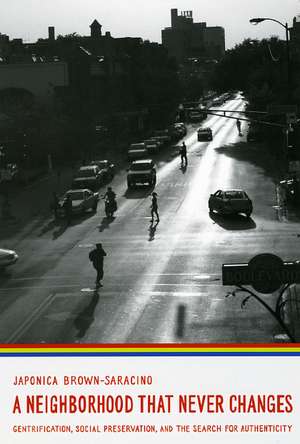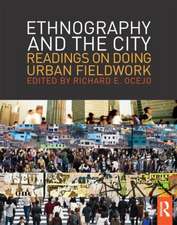A Neighborhood That Never Changes: Gentrification, Social Preservation, and the Search for Authenticity: Fieldwork Encounters and Discoveries
Autor Japonica Brown-Saracinoen Limba Engleză Paperback – feb 2010
Newcomers to older neighborhoods are usually perceived as destructive, tearing down everything that made the place special and attractive. But as A Neighborhood That Never Changes demonstrates, many gentrifiers seek to preserve the authentic local flavor of their new homes, rather than ruthlessly remake them. Drawing on ethnographic research in four distinct communities—the Chicago neighborhoods of Andersonville and Argyle and the New England towns of Provincetown and Dresden—Japonica Brown-Saracino paints a colorful portrait of how residents new and old, from wealthy gay homeowners to Portuguese fishermen, think about gentrification.
The new breed of gentrifiers, Brown-Saracino finds, exhibits an acute self-consciousness about their role in the process and works to minimize gentrification’s risks for certain longtime residents. In an era of rapid change, they cherish the unique and fragile, whether a dilapidated house, a two-hundred-year-old landscape, or the presence of people deeply rooted in the place they live. Contesting many long-standing assumptions about gentrification, Brown-Saracino’s absorbing study reveals the unexpected ways beliefs about authenticity, place, and change play out in the social, political, and economic lives of very different neighborhoods.
The new breed of gentrifiers, Brown-Saracino finds, exhibits an acute self-consciousness about their role in the process and works to minimize gentrification’s risks for certain longtime residents. In an era of rapid change, they cherish the unique and fragile, whether a dilapidated house, a two-hundred-year-old landscape, or the presence of people deeply rooted in the place they live. Contesting many long-standing assumptions about gentrification, Brown-Saracino’s absorbing study reveals the unexpected ways beliefs about authenticity, place, and change play out in the social, political, and economic lives of very different neighborhoods.
Din seria Fieldwork Encounters and Discoveries
-
 Preț: 257.92 lei
Preț: 257.92 lei -
 Preț: 234.36 lei
Preț: 234.36 lei -
 Preț: 215.80 lei
Preț: 215.80 lei -
 Preț: 167.22 lei
Preț: 167.22 lei -
 Preț: 232.07 lei
Preț: 232.07 lei -
 Preț: 175.99 lei
Preț: 175.99 lei -
 Preț: 238.58 lei
Preț: 238.58 lei - 42%
 Preț: 132.99 lei
Preț: 132.99 lei - 19%
 Preț: 166.87 lei
Preț: 166.87 lei - 21%
 Preț: 482.02 lei
Preț: 482.02 lei - 27%
 Preț: 135.96 lei
Preț: 135.96 lei - 23%
 Preț: 584.28 lei
Preț: 584.28 lei - 23%
 Preț: 573.15 lei
Preț: 573.15 lei - 13%
 Preț: 207.00 lei
Preț: 207.00 lei - 19%
 Preț: 148.93 lei
Preț: 148.93 lei - 13%
 Preț: 207.00 lei
Preț: 207.00 lei
Preț: 320.80 lei
Nou
Puncte Express: 481
Preț estimativ în valută:
61.38€ • 64.26$ • 50.79£
61.38€ • 64.26$ • 50.79£
Carte tipărită la comandă
Livrare economică 07-21 aprilie
Preluare comenzi: 021 569.72.76
Specificații
ISBN-13: 9780226076638
ISBN-10: 0226076636
Pagini: 352
Ilustrații: 22 halftones, 3 maps, 10 tables
Dimensiuni: 152 x 229 x 23 mm
Greutate: 0.48 kg
Ediția:New.
Editura: University of Chicago Press
Colecția University of Chicago Press
Seria Fieldwork Encounters and Discoveries
ISBN-10: 0226076636
Pagini: 352
Ilustrații: 22 halftones, 3 maps, 10 tables
Dimensiuni: 152 x 229 x 23 mm
Greutate: 0.48 kg
Ediția:New.
Editura: University of Chicago Press
Colecția University of Chicago Press
Seria Fieldwork Encounters and Discoveries
Notă biografică
Japonica Brown-Saracino is assistant professor in the Department of Sociology and a faculty fellow in the Center for Urban Research and Learning at Loyola University Chicago.
Cuprins
Preface ix
Acknowledgments
Introduction
1 The Research Sites and Methods
2 Beyond Pioneering: Social Homesteaders as Uneasy Gentrifiers
3 Social Preservation
4 The Varying Strategies of Social Preservation
5 The Real People: Selecting the Authentic Old-Timer
6 Locating Social Preservation
7 Self-Representation: Old-Timers’ Perspectives
Conclusion
Appendix 1: Research and Sampling Methods
Appendix 2: Interview Guide
Notes
References
Index
Acknowledgments
Introduction
1 The Research Sites and Methods
2 Beyond Pioneering: Social Homesteaders as Uneasy Gentrifiers
3 Social Preservation
4 The Varying Strategies of Social Preservation
5 The Real People: Selecting the Authentic Old-Timer
6 Locating Social Preservation
7 Self-Representation: Old-Timers’ Perspectives
Conclusion
Appendix 1: Research and Sampling Methods
Appendix 2: Interview Guide
Notes
References
Index










